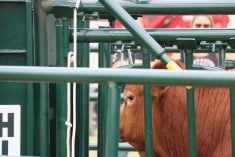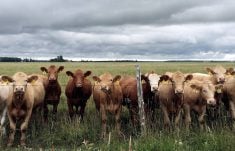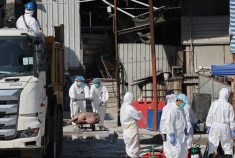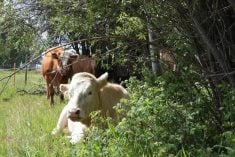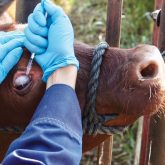DVM
Vaccines cost money and take effort to administer. We must maximize the immune response to get maximum protection of our livestock ensuring protection from disease. This is good from both a biosecurity standpoint as well as an economic one. Clinical disease such as scours, pneumonia outbreaks or abortions all affect our bottom line. This article will closely outline where vaccine failures happen. Often a small effort or preplanning and adhering to a few principles can assure you get maximum benefit from your vaccination program.
Gone are the days when farmers only administered blackleg. This was a fairly tough vaccine. Efficacy was fairly high as well as the level of immunity. In short, it was hard to muck it up unless vaccine expired or was exposed to the elements. Nowadays, multiple vaccines are given in all types of weather and some vaccines are fragile. So extra care must be taken.
Read Also

Beekeepers want financial protection against tropi mite
What happens to beekeepers if the deadly tropi mite reaches Canada? Discover why farmers want robust compensation to protect pollination.
First, establish which diseases you are most concerned about and then establish which vaccines give you this combination with the least amount of shots. Multiple shots do increase the chances of mistakes. If multiple vaccines are given, I adhere to several principles that minimize chances of muck-ups. First off, depending on the weather have a cooler or Styrofoam box which prevents overheating in summer and, more importantly, freezing in winter.
You can place ice packs in for the summer and warm water bottles in the winter. You know the saying about the weather changing quickly so be prepared. Warm, sunny days can turn into blustery winter days in a heartbeat, so an insulated container can save the day. Depending on how hot or cold it is even the syringe loaded with the vaccine needs to be protected. We ideally want it in the five to 15 C range before administration. Keep in mind it is going into an animal with a 38 to 39 C (approx 100 F) temperature so warmer is better than cooler. If any freezing or crystallization occurs, the vaccine is lost and must be disposed of.
It is no use giving inactivated substandard vaccine when so much depends on it working properly. Storing it in an insulated container also keeps the vaccine out of sunlight, which is also a good thing.
If more than one person is vaccinating, split the shots over both sides of the neck. Give subcutaneously wherever possible. It is absolutely imperative the automatic guns don’t get mixed up halfway through processing. With the majority of vaccines now a two-cc dosage, guns are often refilled at the same time and mix-ups can occur. As an example, if you were giving a blackleg vaccine (they often have formalin in the bacterin) and then refilled it with a four-way modified live vaccine even a very small amount of blackleg vaccine left would inactivate the viral vaccine. The next full syringe of 25 doses would be useless.
To avoid this, I closely note the colour of the vaccine, plus I mark the syringe with the vaccine name. I keep the refill bottles together with the vaccine gun and if two or more shots are given on the same side, make a definite separation on the table shelf where they are placed.
Likewise separation on the table needs to be followed by separation at the site of injection. I recommend at least 10 cm distance between injection sites and the farther the better. In order to follow up vaccine reaction if they occur always give one vaccine for instance high on the neck, the other low. The secondary site is behind the shoulder or elbow. Be cognizant of the times there is lots of backflow of vaccine or you go in and out and squirt vaccine in the air. If in doubt revaccinate right then. Monitor the usage to make sure the gun is dispensing the right amount, make sure air is out of the syringe and as always, change bent, burred, dull or dirty needles.
Vaccine reactions (lumps or swellings) are normal. What we want to avoid are infected sites or putting the vaccine intradermal (between the skin layers) or intramuscular if it is recommended subcutaneously. A number of vaccines can be given either subcutaneously or intramuscular. When cleansing syringes just use warm water, no soaps or disinfectants unless they are thoroughly washed and dried afterwards.
With modified live vaccine don’t mix up more than you are going to use in the next hour and discard unused product at the end of the day. If drawn out sterilely killed vaccines and bacterins can be kept for a period (I use one week) and used up later.
One must be cognizant of how the vaccine has been stored before you purchase it. We send purchases home with ice packs in the summer and only use pharmaceutical suppliers we can trust. One fault in this supply chain can render vaccine inactive. Many producers bring in their cooler if purchasing large quantities of vaccine so the temperature integrity is maintained.
When handling cattle, try and be diligent and vaccinate everyone. With escapees, try your best to rerun them. In order to develop an immune response cattle must be healthy in good nutrition and as stress free as possible. The vaccine is only as protective as the response the animal can muster.
This is another common reason vaccinating can fail to protect. Always watch for expiry dates. I had one, I thought, educated producer tell me he thought vaccines lose about 10 per cent efficacy every year past expiry. This is the biggest misnomer I have ever heard. No wonder he had a blackleg outbreak using vaccine that had expired nine years previously.
With so many different combinations of vaccines out there, make sure the diseases you want to protect are in the vaccines. Producers may say I thought everything was in the eight-way vaccine.
Vaccinate according to label instructions, have the cattle healthy and you can expect maximum protection. Vaccines form in my mind the most integral part of any biosecurity program. If you hold back on vaccinations for diseases in your area eventually there will be consequences. Veterinarians will give you a list of vaccines from most critical to least and your decisions can be made on that.
Roy Lewis is a large-animal veterinarian practising at the
Westlock Veterinary Centre. His main interests are bovine
reproduction and herd health.



